
Skanderborg is a town in Skanderborg municipality, Denmark. It is situated on the north and north eastern brinks of Skanderborg Lake and there are several smaller ponds and bodies of water within the city itself, like Lillesø, Sortesø, Døj Sø and the swampy boglands of Eskebæk Mose. Just north of the town on the other side of Expressway E45, is the archaeologically important Illerup Ådal. Over time, the town has grown into a suburb of Aarhus to the north east, connected by the urban areas of Stilling, Hørning and Hasselager.
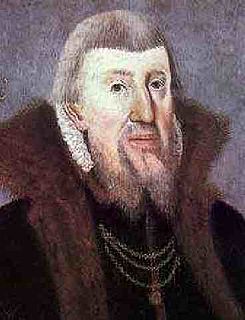
Peder Skram was a Danish Admiral and naval hero.

Herluf Trolle was a Danish naval hero, Admiral of the Fleet and co-founder of Herlufsholm School, a private boarding school at Næstved on the island of Zealand in Denmark.
Mogens Gøye was a Danish statesman and Steward of the Realm, whose enormous wealth earned him the derogatory nickname "the King of Northern Jutland". Gøye was the Royal councillor of Danish Kings John I, the feuding Christian II and Frederick I, and Christian III. He was a key supporter of the Reformation in Denmark-Norway and Holstein. Often lauded by elder Danish historians as a knightly, social liberal upper-class idealist, Gøye is today viewed as a realist statesman understanding the need of a government and a moderate political attitude of the nobility.
Herlufsholm School is a private day and boarding school by the River Suså in Næstved, about 80 kilometers south of Copenhagen. Herlufsholm was founded in 1565 as a boarding school for "sons of noble and other honest men" on the site of a former Benedictine monastery from the 12th century.

The former Diocese of Børglum was a Roman Catholic diocese in Northern Jutland, Denmark. It has also been referred to as the Diocese of Vestervig or the Bishopric of Vendsyssel. The diocese included Vendsyssel, Hanherred, Thy, and Mors.

The former Roman Catholic bishopric of Odense was a diocese in Denmark which included the islands of Funen, Langeland, Tåsinge, Lolland, Falster, Als, and Ærø. Its episcopal see was located in Odense at St. Canute's Cathedral.
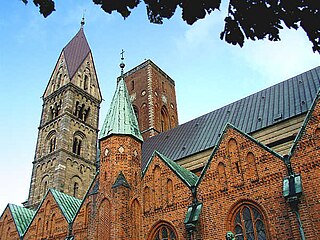
The former Diocese of Ribe was a Roman Catholic diocese in Southern Jutland, Denmark. The diocese was established in 948, and dissolved in 1536 during the Protestant Reformation. Within the newly established protestant Church of Denmark, the Diocese of Ribe effectively replaced its Roman Catholic precursor.

Øm Abbey was a Cistercian monastery founded in 1172 in the Diocese of Aarhus near the town of Rye, between the lakes of Mossø and Gudensø in central Jutland, Denmark. It is one of many former monasteries and abbeys in the highland region of Søhøjlandet.

Roskilde Abbey or Our Lady's Abbey, Roskilde, was a nunnery dedicated to Saint Mary the Virgin. The abbey was located at Roskilde on the Danish island of Zealand. It was founded in the early 12th century for Benedictine nuns, but in 1177 became part of the Cistercian reform movement. The abbey was suppressed in 1536 during the Protestant Reformation in Denmark. It is now the site the Old Church of Our Lady, Roskilde .
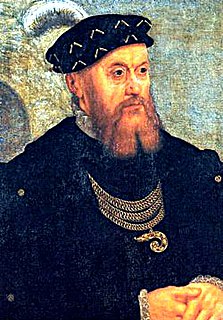
The election of Christian III as king of Denmark on 4 July 1534 was a landmark event for all of Denmark and also Norway. It took place in St. Søren's Church in the town of Rye in eastern Jutland, where the Jutlandic nobility elected Prince Christian, son of King Frederick I and Duke of Schleswig and Holsten, as king. This brought about the Count's Feud and later also led to the implementation of the Protestant Reformation in Denmark and Norway.
St. Peders Kloster, later called Skovkloster, was an important early Benedictine house at Næstved, Denmark, active in 1135-1559.

Vrejlev Priory is a former Danish priory which dates back to the 13th century. The priory located at Vrejlev, near Vrå, Region Nordjylland, Denmark. Between 1165 and the Protestant Reformation, it was operated as a Premonstratensian nunnery.
St. Agnes Priory was established by Queen Margaret I for a community of Dominican nuns at Gavnø Island. After the Danish Reformation the priory was transformed into a manor estate known as Gavnø Castle located near Næstved, Denmark.

Veng Abbey was one of Denmark's earliest Benedictine monasteries. It was located in the village of Veng near Skanderborg, Region of Southern Denmark. Veng Church, the former abbey church, is still in use as a parish church and is the oldest remaining in the country.
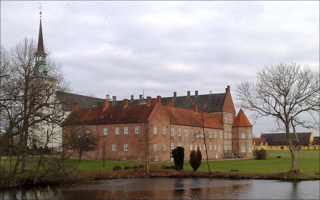
Brahetrolleborg is a castle about 10 kilometres north-west of Fåborg on the Danish island of Fyn. Before the Reformation it was Holme Abbey, a Cistercian monastery.
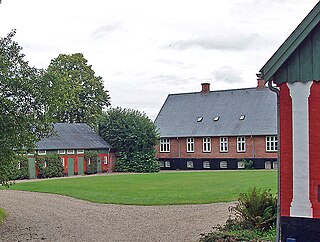
Voer Abbey was a Benedictine abbey in Voerladegård parish in Skanderborg Municipality, Denmark. It was situated on the Gudenå River near Klostermølle, site of the former monastery mill.

Birgitte Gøye was a Danish county administrator, lady in waiting, landholder and noble, co-founder and principal of Herlufsholm School.
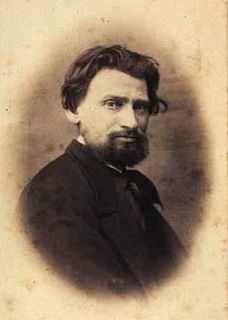
Otto Frederik Theobald Evens was a Danish sculptor.

Østbirk Church is a parish church in Horsens Municipality. It is overseen by the Diocese of Aarhus in the Church of Denmark.
















